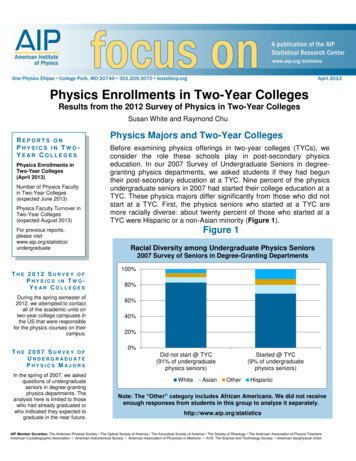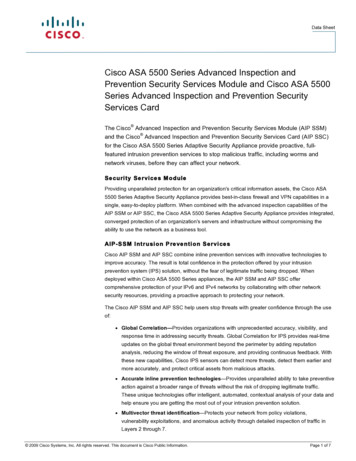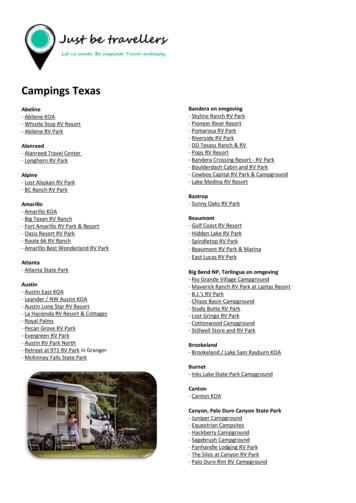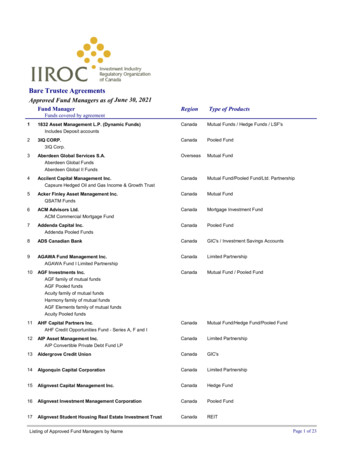
Transcription
www.aip.org/statisticsOne Physics Ellipse College Park, MD 20740 301.209.3070 stats@aip.orgApril 2013Physics Enrollments in Two-Year CollegesResults from the 2012 Survey of Physics in Two-Year CollegesSusan White and Raymond ChuREPORTS ONPHYSICS IN TWOYEAR COLLEGESPhysics Enrollments inTwo-Year Colleges(April 2013)Number of Physics Facultyin Two-Year Colleges(expected June 2013)Physics Faculty Turnover inTwo-Year Colleges(expected August 2013)For previous reports,please visitwww.aip.org/statistics/undergraduatePhysics Majors and Two-Year CollegesBefore examining physics offerings in two-year colleges (TYCs), weconsider the role these schools play in post-secondary physicseducation. In our 2007 Survey of Undergraduate Seniors in degreegranting physics departments, we asked students if they had beguntheir post-secondary education at a TYC. Nine percent of the physicsundergraduate seniors in 2007 had started their college education at aTYC. These physics majors differ significantly from those who did notstart at a TYC. First, the physics seniors who started at a TYC aremore racially diverse: about twenty percent of those who started at aTYC were Hispanic or a non-Asian minority (Figure 1).Figure 1Racial Diversity among Undergraduate Physics Seniors2007 Survey of Seniors in Degree-Granting DepartmentsTHE 2012 SURVEY OFPHYSICS IN TWOYE AR COLLEGESDuring the spring semester of2012, we attempted to contactall of the academic units ontwo-year college campuses inthe US that were responsiblefor the physics courses on theircampus.THE 2007 SURVEY OFUNDERGRADUATEPHYSICS M AJORSIn the spring of 2007, we askedquestions of undergraduateseniors in degree-grantingphysics departments. Theanalysis here is limited to thosewho had already graduated orwho indicated they expected tograduate in the near future.100%80%60%40%20%0%Did not start @ TYC(91% of undergraduatephysics seniors)WhiteAsianStarted @ TYC(9% of undergraduatephysics seniors)OtherHispanicNote: The “Other” category includes African Americans. We did not receiveenough responses from students in this group to analyze it separately.http://www.aip.org/statisticsAIP Member Societies: The American Physical Society The Optical Society of America The Acoustical Society of America The Society of Rheology The American Association of Physics TeachersAmerican Crystallographic Association American Astronomical Society American Association of Physicists in Medicine AVS: The Science and Technology Society American Geophysical Union
Page 2focus on Physics Enrollments in Two-Year CollegesFigure 2High School Physics Experience for Undergraduate PhysicsSeniors by First Post-Secondary Institution2007 Survey of Seniors in Degree-Granting DepartmentsHighest Level Physics Takenin High School100%Physics majors whostarted at a TYC seem tohave had a verydifferent experiencewith physics in highschool when comparedto those who did notstart at a TYC.Was AP Physics offered atyour high %28%20%40%39%Started @ TYC0%Did not Start @TYCStarted @ TYC25%40%32%20%2%6%0%Did not start @TYCNoneConceptual GeneralHonorsAPAP not offeredUnsureAP offeredNote: About 95% of US high school seniors are enrolled in high schoolswhere physics is available.http://www.aip.org/statisticsA second major difference between physics seniors who started at aTYC and those who did not is their high school physics experience.More than one-fourth of those who started at a TYC did not takephysics in high school, and only 18% took AP physics. (See Figure2.) The 6% of those who did not start at a TYC and did not takephysics is consistent with the 5% of high school seniors who attend aschool where physics is not offered.This apparent difference of interest in physics in high school is alsoevident from their knowledge about AP physics offerings: 25% ofthose who started at a TYC did not know if AP physics was offered attheir high school versus only 5% of those who did not start at a TYC.Since their high school physics experiences were so different, it islikely that something happened in their physics courses at the TYCthat captured these students’ interest in physics.April 2013AIP Statistical Research Center
focus on Physics Enrollments in Two-Year CollegesPage 3Two-Year Colleges: Finding PhysicsBefore we can discuss the prevalence of physics offerings at two-yearcolleges, we must first determine how many two-year colleges mightreasonably be expected to offer courses in physics. This task is not asstraightforward as one might expect. Some schools consist of only onecampus, while others have multiple campuses. In addition, the name ofthe administrative unit where physics courses are taught may differ atdifferent campuses of the same school and does differ across institutions.We began with the US Department of Education’s Integrated Postsecondary Education Data System (IPEDS). While some bachelor’sgranting institutions have historically offered associate’s degrees(ADs), some TYCs now offer bachelor’s degrees. So, we could notlimit our search to schools that offered only ADs. We did limit oursearch to schools where at least 70% of the degrees awarded wereADs. We further restricted the schools to those that averaged awardingat least 25 ADs for each year the school was in operation between2001 and 2010. This list included 1,199 schools.We estimate thatphysics is offered at63% of TYC campuses.These campusesaccount for 88% of theADs awarded at TYCsbetween 2001 and 2010.We excluded 106 of these schools because they had limited academicofferings (Bible schools, schools of fashion merchandising, dramaticarts, and visual arts, for example). Thus, we estimate that there were1,093 schools that might offer physics.Knowing that there were 1,093 schools that might offer physics wasnot the final answer, however, since some entities that are represented by one listing in IPEDS actually consist of many campuses. Forexample, Ivy Tech Community College (Indiana) is one entry in IPEDS,and there are 31 locations listed on the Ivy Tech website. What wereally want to know is how many campuses there are where we mightreasonably expect physics to be offered.Based on stratified sampling (oversampling the smaller schools) andweb searches for the sampled schools, we estimate that there are1,681 campuses that might offer physics. Furthermore, we estimatethat 63% of these campuses (1,060) do offer physics. This number islittle changed from earlier studies; 1,056 campuses offered physics in1995, and 1,072 campuses offered physics in 2001. Even thoughphysics is offered on 63% of the campuses, it is important to note thatthese campuses account for 88% of the ADs awarded at TYCsbetween 2001 and 2010.AIP Statistical Research CenterApril 2013
Page 4focus on Physics Enrollments in Two-Year CollegesPhysics Offerings in Two-Year CollegesWhat types of physics courses are taught on these campuses?Figure 3 depicts the findings of our survey. The most commonlytaught course is the algebra-trig-based physics class, which is taughtat 94% of the campuses where physics is offered; this is up from2001. In every case, except for Other Physics, the proportion ofcampuses offering various types of physics courses has increasedsince 2001.Figure 3Two-Year College Physics* Offeringsby Type of Courseat TYC Campuses that Offer Any Physics, 2001 & 20110%Physical science andphysics / physicalscience courses foreducation majorsaccounted for almostone-fourth of the totalenrollment in physicscourses in two-yearcolleges in 2011.20%Physics / Phys Sci for Ed100%30%ConceptualOther Phys80%84%94%Algebra-Trig basedPhysical Sci60%72%79%Calculus-basedTech / Applied40%54%21%26%15%47%10%20013%201113%31%* Includes physical science courses that are at least 50% physicshttp://www.aip.org/statisticsWe estimate that more than 215,000 students were enrolled in aphysics or physical science course in a two-year college during the2011-2012 academic year. (For courses that are taught in sequencesacross two or more semesters or quarters, these data include onlyenrollments in the first course of the sequence.) This is up from the120,000 students estimated to have taken physics courses during the1995-1996 academic year. Thus, physics enrollments grew at a 3.7%compound annual average rate over this 16-year period; this is on parwith growth in full-time enrollments at TYCs over this same timeframe.April 2013AIP Statistical Research Center
focus on Physics Enrollments in Two-Year CollegesPage 5Figure 4 provides enrollments by type of course. The number of students enrolled in algebra-trig-based and conceptual physics coursesin two-year colleges has doubled, while enrollments in physicalscience and physics for education majors have almost quadrupled.The number of students taking calculus-based physics courses atTYCs has grown by about 50% and enrollments in other types ofphysics courses have dropped.Figure 4Number of Students Enrolled in Physicsǂ in Two-Year Collegesby Academic Year & Type of Course020111995ǂin Thousands10050422778401915041242001639Enrollment in physicscourses in two-yearcolleges almost doubledbetween 1995 and 2011.10Calculus-basedAlgebra-Trig basedOther Physics*Phys Sci / Physics**ConceptualIncludes physical science courses that are at least 50% physics*Includes Technical / applied physics** Includes physical science and physics for education majors1995 data represents the 1995-1996 academic year2011 data represents the 2011-2012 academic yearhttp://www.aip.org/statisticsAs shown in Figure 5 (next page), the proportion of students taking acalculus-based, algebra-trig-based, or conceptual physics course haschanged little; these courses account for over 70% of the studentstaking physics at TYCs. The big changes in enrollment compositionare seen in other physics and physical science & physics for educationmajors. Fewer than 11,000 students were enrolled in technical orapplied physics in 2011; this is on par with enrollments in 1995. Thelarge drop in the other physics category (which includes technical orapplied physics) is in other physics courses: 13,000 students wereenrolled in other types of physics courses in 1995, while these coursesaccounted for only 5,000 students in 2011. Perhaps the physicsAIP Statistical Research CenterApril 2013
Page 6focus on Physics Enrollments in Two-Year Collegescurriculum in TYCs is becoming more closely aligned with that in fouryear schools. Of course, as part of their mission, TYCs serve the localcommunity, so it is likely that there will be physics courses on somecampuses that are tailored to meet local needs.Figure 5Enrollment Distribution in Physicsǂ Courses at Two-Year Collegesby Academic Year & Type of Class0%Calculus- and algebratrig-based physicscourses accounted forover half of theenrollments in both1995 and lus-basedAlgebra-Trig basedOther Physics*Phys Sci / Physics**7%100%18%20%8%ConceptualIncludes physical science courses that are at least 50% physics*Includes Technical / applied physics** Includes physical science and physics for education majors1995 data represents the 1995-1996 academic year2011 data represents the 2011-2012 academic yearhttp://www.aip.org/statisticsPostsecondary PhysicsWhen we compare physics enrollments in two-year colleges to physicsenrollments in schools that offer at least a bachelor’s degree, we seethat TYCs account for about 30% of the total physics enrollments. Atschools that granted at least a bachelor’s degree in physics, totalphysical science plus physics enrollments (Calculus-based, Algebratrig-based, and Conceptual) were about 380,000 in 1995, and theygrew to about 500,000 in 2010 (the latest year for which data arecurrently available). In TYCs, enrollments in these courses were86,000 in 1995 and almost 161,000 in 2011. (See Figure 6 on nextpage.)April 2013AIP Statistical Research Center
focus on Physics Enrollments in Two-Year CollegesPage 7Figure 6Number of Students Enrolled in Physics and Physical Science* Coursesat TYCs and Institutions that offer a Bachelor’s in Physics500400Physical Science300Other PhysicsConceptual200Algebra-Trig based100Calculus-basedEnrollments in physicsand physical sciencecourses have grownfaster at TYCs than atfour-year schools thatoffer at least abachelor’s degree 0102011* Includes physical science courses that are at least 50% physicshttp://www.aip.org/statisticsAnother way to look at the contribution of TYCs to postsecondaryphysics education is to consider the proportion of student enrollment ineach type of physics course that is taught at TYCs versus degreegranting physics departments. This is shown in Figure 7 (next page).In 1995, about 20% of students taking physics (calculus-based,algebra-trig-based, and conceptual) were enrolled in these courses atTYCs. The most recent data shows that about 26% of students inthese courses were taking them at TYCs. (As noted previously, forcourses that are taught in sequences across two or more semesters orquarters, these data include only enrollments in the first course of thesequence.)The distribution varies by class, with students in calculus-basedphysics courses most likely to be enrolled in degree-grantingdepartments. We must note that, in some engineering schools, the engineering students take their physics courses in the school ofengineering. These students are not included in these data; these datainclude only students in degree-granting physics departments in fouryear colleges and universities.AIP Statistical Research CenterApril 2013
Page 8focus on Physics Enrollments in Two-Year CollegesFigure 7Total Student Enrollment in Physics Coursesby Type of Institution100%15%17%22%80%The proportion ofstudents taking theirpostsecondary physicscourses at TYCs 11Alg/trig-based19952010/11Conceptual4-year, degree-grantingTotalTYCsThe enrollment data for four-year schools is forphysics-degree-granting departments only.The 2010/11 data is 2010 data for 4-year schools and 2011 data for TYCs.http://www.aip.org/statisticsAstronomy in Two-Year CollegesIn addition to examining physics offerings, we also collected dataabout astronomy offerings at TYCs. In 2011, we estimate that 71% ofTYCs that offered physics courses also offered astronomy courses. Itis possible that there are TYCs that offer astronomy that do not offerphysics; data for these schools are not included in our estimates. Weestimate that 51,000 students took an astronomy course at a TYC in2011. We did not collect data on astronomy courses in our earlier TYCstudies, so we cannot make historical comparisons. However, we dohave data on enrollments in astronomy courses taught by physicsdepartments that offer at least a bachelor’s degree in physics and inastronomy courses taught by departments that offer a degree inastronomy – both stand-alone astronomy departments and combinedphysics and astronomy departments. These data are highlighted inTable 1 (next page). The number of students enrolled in introductoryastronomy courses at TYCs are equivalent to that in departments thatgrant at least bachelor’s degrees in astronomy.April 2013AIP Statistical Research Center
focus on Physics Enrollments in Two-Year CollegesPage 9Table 1Enrollments in Introductory Astronomy Coursesin TYCs and Departments Offering at least Bachelor’s DegreesInstitution/DepartmentYearIntroductory AstronomyEnrollmentsTYCs201151,000Physics degree-granting2010144,000Astronomy degree-granting201052,000The number of studentsenrolled in introductoryastronomy courses atTYCs are equivalent tothat in departments thatgrant at least bachelor’sdegrees in astronomy.Note: The data for the astronomy degree-granting departments includesdepartments that offer degrees in both physics and astronomy.http://www.aip.org/statisticsSurvey MethodologyIn the Fall of 2011, we compiled a list of TYC campuses that webelieved offered physics and likely best physics contacts at thosecampuses. We reached out to American Association of PhysicsTeachers (AAPT) members at TYCs to help ensure we were includingall appropriate campuses. We also worked with the AmericanChemical Society (ACS) when we learned they would be conducting asurvey of chemistry in TYCs since physics and chemistry are often inthe same administrative unit at TYCs. We also visited the website orcontacted someone at 80 campuses – oversampling small campuses –to help us better determine where physics was and was not offered.Between March 1 and June 30, 2012, we attempted to reach thephysics contact by e-mail multiple times. On June 12, we sent apostcard to approximately 600 campuses that had not yet responded.We had physics contacts for 111 of those campuses; the remainingpostcards were addressed to “Physics Faculty”.We received useable responses from 442 campuses; this is 42% ofthe campuses we believe offer physics. Final estimates were scaledbased on the number of associate degrees awarded. We received ahigher proportion of responses from larger schools, and a smallerproportion from smaller schools, but the results have been adjusted toreflect that.We offer sincere gratitude to all those who helped compile this data. Ifyou have any questions or comments, please contact Susan White atswhite@aip.org.AIP Statistical Research CenterApril 2013
Page 10focus on Physics Enrollments in Two-Year Collegese-UpdatesThank you for your interest in our study of physics in two-yearcolleges. We also have data on physics in US high schools, physics indegree-granting departments, underrepresented minorities in physics,global physics, and careers. If you would like to be notified when wepost a new report on a topic that interests you, please sign up for ourdata alerts at www.aip.org/statistics/e updates.We promise not to share your contact information with any otherparties. You will be asked to indicate areas of interest to you. Wepromise not to overfill your inbox since we typically send about 20 eUpdates each year, averaging fewer than two each month.April 2013AIP Statistical Research Center
little changed from earlier studies; 1,056 campuses offered physics in 1995, and 1,072 campuses offered physics in 2001. Even though physics is offered on 63% of the campuses, it is important to note that these campuses account for 88% of the ADs awarded at TYCs between 2001 and 2010. We estimate that physics is offered at










